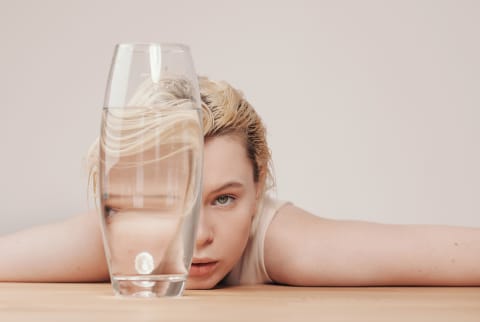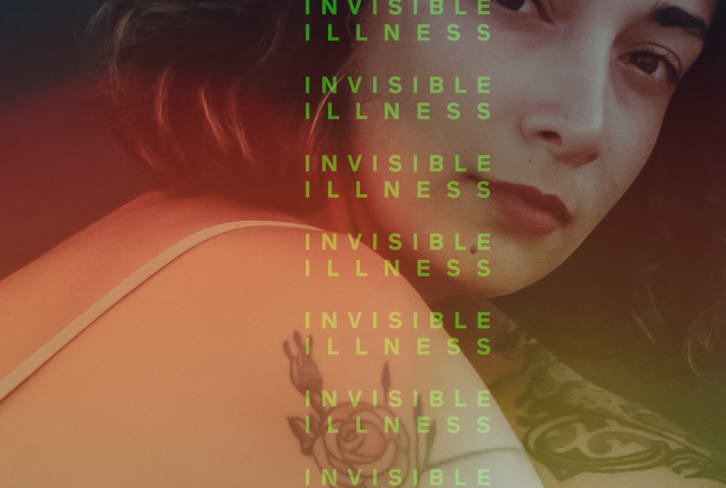Advertisement
Here Are 7 Optometrist-Approved Ways To Naturally Alleviate Dry Eyes


Add this to the column of things I never thought I’d have to deal with: insanely dry eyes. I’m not talking just a little dry. By the end of most days, it feels like my eyes have ceased to produce any tears whatsoever, and my contact lenses remain glued to my eyeballs until I frantically douse them with contact solution.
Of course, I know what my problem is. It’s the same problem countless desk jockeys are plagued with—way too much screen time. Turns out, workers who spend the most time on the computer have the lowest concentrations of something called mucin 5AC, a component of our eyes’ aqueous mucous layer that’s supposed to keep things nice and lubricated. “We’re supposed to blink around 10 to 12 times per minute, which helps maintain this tear film. But when focusing on a screen, blinking slows to an average of three to four times a minute, which causes irritation and fatigue,” says Marc Grossman, O.D., holistic optometrist and author of Natural Eye Care.
The good news: Even if you can’t break away from your screen, there’s still a lot you can do to keep eyes naturally moist and pain-free, from supplementing your diet with key nutrients to giving yourself an eye massage.
Slash sugar, load up on leafy greens.
“Consumption of 11 teaspoons of sugar a day has been linked to dry eye syndrome,” says Grossman. “It's thought that excess sugar in the diet results in too much unusable glucose in the eyes, and more than half of all diabetics suffer from dry eye syndrome.” You probably don’t need much convincing to nix refined sugars from your diet, but what should you load up on? Grossman suggests leafy greens, a sentiment that’s seconded by registered dietitian Jess Cording, R.D., who also recommends a variety of colorful fruits and veggies for a concentrated dose of antioxidants (including zeaxanthin, lutein, and astaxanthin) that have been specifically shown to benefit eye health.
Supplement strategically.
While evidence1 is mixed on whether or not2 supplements like fish oil or flaxseed oil can help with dry eyes, Grossman recommends them to his patients, citing research showing that high intakes of omega-3 fatty acids can significantly reduce dry eye syndrome symptoms by improving the coating of tears that cover the front of the eye and reducing inflammation. Vitamin D may have a similar benefit, with some research showing that dry eye and impaired tear function are symptoms of low vitamin D levels. As weird as it sounds, gut issues such as IBS have also been associated with3 dry eye, which is why Grossman recommends a high quality probiotic supplement to support overall gut health.
Hydrate, hydrate, hydrate.
Be sure to wash down those supplements with plenty of water. Both Grossman and the American Academy of Ophthalmology recommend drinking 8 to 10 glasses of water a day to help promote tear production and alleviate dry eyes.
Invest in amber glasses.
They may not be the cutest, but amber-hued glasses are an effective way of filtering out blue light from our tech devices and have been shown to help reduce dry eye symptoms, says Grossman. Beyond that, they can also help counter the effects of blue light on our hormones and menstrual cycle when worn with the natural light-dark cycles of the planet by helping raise melatonin levels and bring down cortisol levels at night, according to women’s health and hormone expert Jolene Brighten.
Do a twice-a-day warm compress.
A warm compress with a wet washcloth can is an effective way of opening up oil glands in the eyelids, allowing natural oils to flow back into the eye, slow tear evaporation, and relieve discomfort from dry eye triggers like contact lenses or too much screen time. Grossman suggests applying a warm compress for 10 minutes two to three times a day. You can also try gently massaging your upper and lower eyelids while you’re in the shower, which will stimulate tear glands.
Try the squeeze and release method.
Researchers have discovered that equally important to blinking is blinking completely, says Grossman. So, make sure that when you blink you close your eyelids fully. Or set a timer to go off a few times per day and do the following simple exercise: Close your eyes, squeeze your eyes tight, then relax your eyes while keeping them closed. Open your eyes and repeat about five times.
Opt for preservative-free eye drops.
While dietary and lifestyle tweaks are great, none of us are above eye drops, or artificial tears. In those ultra dry, sandpapery moments, you need that immediate relief. But don’t reach for just any drops. Grossman warns that drops marketed to "get the red out" may reduce circulation in the eye, limit moisture production, and actually make dry eyes worse. Instead, consider preservative-free artificial tears. These are available in single-dose vials to keep them fresh without chemical preservatives. If you have moderate to severe dry eyes, drops with preservatives may irritate your eyes further.
Watch Next
Enjoy some of our favorite clips from classes
Enjoy some of our favorite clips from classes
What Is Meditation?
Mindfulness/Spirituality | Light Watkins
Box Breathing
Mindfulness/Spirituality | Gwen Dittmar
What Breathwork Can Address
Mindfulness/Spirituality | Gwen Dittmar
The 8 Limbs of Yoga - What is Asana?
Yoga | Caley Alyssa
Two Standing Postures to Open Up Tight Hips
Yoga | Caley Alyssa
How Plants Can Optimize Athletic Performance
Nutrition | Rich Roll
What to Eat Before a Workout
Nutrition | Rich Roll
How Ayurveda Helps Us Navigate Modern Life
Nutrition | Sahara Rose
Messages About Love & Relationships
Love & Relationships | Esther Perel
Love Languages
Love & Relationships | Esther Perel

















